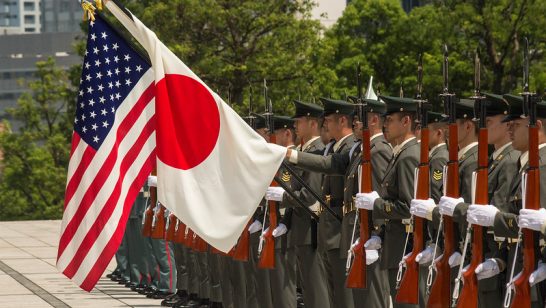
As the international community is commemorating the destruction of Hiroshima and Nagasaki by atomic bombs, it should be recalled that work on such weapons was initiated by one of the most vicious regimes in history, Nazi Germany. Even if nuclear deterrence, despite the lack of hard evidence, can be given the benefit of the doubt for ensuring peace and stability between the two superpowers and their allies during the Cold War, perpetuating such a balance of terror is no longer acceptable to the majority of our societies. The risks for the planet outweigh the alleged security benefits for a few nuclear weapons possessors.
One commonly thinks of the first nuclear weapons as a direct result of the Manhattan Project launched in 1941 by the US President Roosevelt. That unprecedented mobilisation of scientific, industrial, and military resources was in fact the consequence of the warning sent in August 1939 by German Jewish scientists Leo Spitz (aka Szilard) and Albert Einstein to the American leadership about the Nazi project of developing a weapon using nuclear energy. That fear was nurtured by the news of successful uranium fission by German scientists made public in early 1939. While the Nazi regime never dedicated similar resources to research and development of atomic weapons as the US did in collaboration with Great Britain and Canada, it eventually accomplished the release of nuclear energy towards the autumn of 1944, some nine months before the Americans. Hitler was indeed hoping to find the ‘miracle weapon’ that would roll back the Allied advance into Germany or launch a devastating retaliation against British cities.
The advance gained by the US and the collapse of the Nazi war machinery saved the world from a Nazi atomic bomb. But it also allowed the Americans to choose Japan as the target of their first weapons. It did not so much accelerate Japanese capitulation as often claimed, because Tokyo eventually surrendered only after the Soviet Union entered the war by invading Manchuria. Although President Truman did want to end the war as early as possible, the bombing was in fact at the same time a means of testing ‘in real life’ both the fission and the fusion weapons and a demonstration of power directed at the Soviet Union.
In 1945, the Americans were not stopped by any moral or legal consideration as to the risk of causing massive civilian casualties. Conventional ‘strategic bombing’ and firebombing over Germany and Japan had already resulted in hundreds of thousands of civilian victims, many more than would eventually be caused by “Little Boy” and “Fat Man”. Admittedly, only two atomic bombs were used as compared with hundreds of tons of conventional explosives, but their effects were more devastating. The victims which were not instantly killed by the heat and blast succumbed to burns, radiation, and other injuries compounded by illness and malnutrition over several months, not mentioning the increase in stillbirths, birth defects, infant mortality or cancer deaths for many years.
Today, seven decades later, with nine states possessing nuclear weapons, despite the huge decrease in the number of weapons as compared to the Cold War peak (over 15,000 v. 70,000), the destructive power of the remaining nuclear arsenals still almost equals 2,000 times the total firepower used during World War II. One Trident submarine alone can deliver the equivalent of 5,000 Hiroshima-type bombs.
While, fortunately, military doctrines have evolved along with international humanitarian law, making the deliberate targeting of civilians illegal and unacceptable to civilized nations, nuclear-armed states still consider that their security relies precisely on the threat of such mass civilian casualties. By even threatening to use nuclear weapons as retaliation against any attack, including conventional – as several nuclear-weapon states still do – possessors of nuclear weapons are not far from considering them as weapons of terror according to the definition of acts of terrorism proposed by Kofi Annan in 2005: “any action intended to cause death or serious bodily harm to civilians or non-combatants with the purpose of intimidating a population or compelling a government or an international organisation to do or abstain from doing any act.”
Other weapons of mass destruction (chemical and biological) as well as some conventional weapons have been banned or regulated because of their effects on civilians. Isn’t it paradoxical that nuclear weapons, with the most devastating power and potential catastrophic consequences for the whole of humanity, continue to be exempt from this gradual process of prohibition and elimination? The doctrine of nuclear deterrence, as proclaimed by most nuclear-armed countries, precisely considers that any aggressor would be dissuaded by the effects of nuclear weapons which would outweigh any benefits of aggression. But this doctrine only relies on assumptions, equated by some with religious beliefs. If its success were so guaranteed, why would nuclear-armed states invest so much in retaliatory capabilities or antiballistic missile defence?
Some claim that, throughout the Cold War, nuclear weapons ensured peace and stability, but there is no more irrefutable evidence of this assertion than of the contrary. As Noam Chomsky said in 2005: “Surveying the record of astonishingly reckless and irresponsible state actions, repeated and often frightening accidents, and pure luck, one can only conclude that it is remarkable that we have survived the nuclear age thus far.” In today’s unstable and uncertain world, regional conflicts involving nuclear-armed countries can escalate quickly, some powerful non-state actors could take over nuclear weapons. Even in industrially, scientifically and militarily advanced nations, nuclear catastrophes or accidents can happen as in Chernobyl or Fukushima. Many reports show that accidents can also involve nuclear weapons.
Moreover, most nuclear powers today recognise that the main threats to their national security are: terrorist groups; violent extremists; fragile and conflict-affected states that incubate and spawn infectious disease, illicit weapons and drug smugglers, and destabilising refugee flows; failures in governance and endemic corruption; the danger of disruptive and even destructive cyber-attack; or the risk of another global economic slowdown. Can any of such threats or risks seriously be deterred by nuclear weapons? Even considering the potential spread of weapons of mass destruction, can the whole non-proliferation regime remain credible and sustainable until it is based on the argument that nuclear weapons are legitimate for some privileged states to ensure their security but too dangerous in the hands of others?
The opinions articulated above represent the views of the author(s), and do not necessarily reflect the position of the European Leadership Network or any of its members. The ELN’s aim is to encourage debates that will help develop Europe’s capacity to address the pressing foreign, defence, and security challenges of our time.


